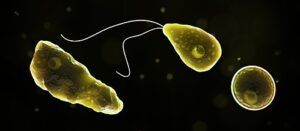
Saline nasal rinses have become very popular, usually to ease symptoms of nasal congestion during colds, allergies, or sinus infections. It is very important to only use boiled (and cooled), commercially bottled, sterile, or distilled water for nasal rinses to make sure any harmful microbes and organisms in the water are killed. One person in Texas ignored this advice and paid with her life.
The woman used nonboiled water from the RV faucet (in her RV vehicle), which was unfortunately contaminated with the amoeba Naegleria fowleri. This amoeba traveled to her brain and caused primary amebic meningoencephalitis (PAM), also known as Naegleriasis. Which is almost always fatal. In her case, she died within 8 days from the first symptoms.
Authorities were unable to determine if the amoeba was in the RV campsite drinking system or if it was picked up in another site when filling up her RV's water. But, they did point out that drinking water contaminated with Naegleria fowleri does not cause problems. It is only a problem when rinsing contaminated water into the nasal passages and sinuses - the amoeba can then travel to the brain.
As the CDC points out on its web-site (also see page on safe nasal rinsing):
"Germs such as the amebas Naegleria fowleri and Acanthamoeba can grow in public and private water tanks and pipes. They can also grow in the pipes and water heaters in some homes and buildings.
Naegleria fowleri and Acanthamoeba can pose a serious risk to your health if they are in the water you use to rinse your sinuses or nasal passages. If the amebas go up the nose and to the brain, they can cause nearly always fatal brain infections. Although rare, people have died from rinsing their sinuses with tap water containing Naegleria fowleri and Acanthamoeba."
From CIDRAP (The Center for Infectious Disease Research and Policy at the Univ. of Minnesota): Woman dies from brain ameba after flushing nose with RV water
A previously healthy 71-year-old woman in Texas died within 2 weeks of using tap water from a recreational vehicle (RV) for nasal irrigation. She was diagnosed as having primary amebic meningoencephalitis (PAM) a rare, often fatal brain infection caused by the ameba Naegleria fowleri, according to a report yesterday in Morbidity and Mortality Weekly Report.
CDC and Texas investigators said the woman developed severe neurologic symptoms, including fever, headache, and an altered mental state, within 4 days of using a nasal irrigation device filled with tap water from an RV's water system at a campground in Texas.
Despite medical treatment for suspected PAM, the patient developed seizures and later died 8 days after she first had symptoms. CDC lab testing confirmed the presence of N fowleri in the woman's cerebrospinal fluid.
Investigating the source
A follow-up epidemiologic investigation conducted by the Texas Department of State Health Services found that the woman had no recreational exposure to fresh water, such as swimming, but she had reportedly performed nasal irrigation several times using nonboiled water from the RV water faucet during the 4 days before she fell ill.
This practice suggested two potential water sources for the N fowleri infection. The first was the RV's water tank for drinking, which flowed directly to the faucets and shower. The tank had been filled with water collected on an unknown date before the patient bought the RV 3 months earlier.
The second possible source of contamination was the municipal water system, which was connected by a hose and water filter to the RV's potable water system, bypassing the tank, at the time the woman used it for nasal irrigation.
To explore these potential sources further, investigators collected 12 environmental samples. These included samples from the squirt bottle that the woman used for nasal rinsing, water from the RV water heater, swabs from the shower head and bathroom and kitchen sink faucets, water from the RV's potable water tank, and water from the campsite's municipal water supply.
Although the scientists did not find N fowleri DNA or viable ameba in the samples, they found that the water supply was not adequately disinfected.
The authors note, "Failure to isolate the organism from the samples collected might be explained by the fact that sampling occurred 23 days after the patient used the water for nasal irrigation, and the environmental conditions might have differed from those present when infection occurred.
"In addition, the pathogen might have been present at the time of sampling but at levels below the detection limit. Whether the municipal water system or the RV potable water tank was the source of contamination is unknown, because the tank might have contaminated the RV potable water system before connection to the campground municipal water system."
